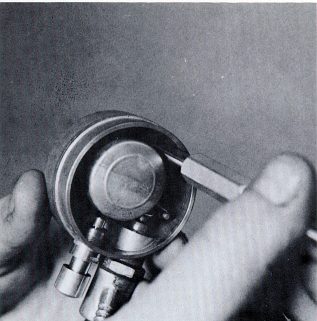
FIG. 141

FIG. 141
9. NOTE: The 24 and 27 mm IRZ carburetors used on the 1971-72 Plonker incorporate a different float mechanism that is not normally adjustable. It uses a concentric type float bowl and float with the jets protruding into the center of the bowl. The plastic float should normally not require any adjustment. If the float should leak or break, it will require replacement.
If a lean condition is present at all throttle openings on the 24 and 27 mm IRZ carburetor, and all things in Sec 1 Paragraph 2 of this chapter are in proper working order, the float mechanism should be checked to insure that the float and the float needle are clean and operate freely and properly. If any trouble is suspected in either the float or the float needle assembly, replace them.
10. ENGINE RUNS RICH AT ALL THROTTLE OPENINGS. If the engine shows rich symptoms at all throttle openings, and all things mentioned in Sec 1, Paragraph 2 of this chapter are in proper order, check the float and float mechanism and set the float as described in Sec 2, Paragraphs 7, 8 and 9 of this chapter.
11. Check the float needle and float metering jet for dirt or grit. Any foreign material in this area can interfere with the correct seating of the float needle, thereby allowing fuel to enter the float bowl after the float has reached the proper level.
Also, it is essential that the float itself be airtight, otherwise fuel can enter it, making it heavier, consequently raising the fuel level excessively. Both of these problems will usually result in the fuel level becoming high enough to spill over outside the carburetor and also allow raw fuel to enter and flood the engine.
12. ENGINE RUNS LEAN AT ONE OR SEVERAL THROTTLE POSITIONS. If the engine shows lean symptoms at one or more throttle openings, but not all of them, refer to the part of Chapter 1 that pertains to the carburetor you are tuning.
For instance, if your 1972 250 Pioneer gives symptoms of being lean at 3/4 to full throttle ' you will need to refer first to Chapter ' 1, Section 1. This tells you that Sections 2 through 7 cover the operation of the 29 mm carburetor as fitted to the 1972 250 Pioneer. Then move to Section 6 of the same chapter, which covers the 3/4 to full throttle operation of that carburetor. Read
Page 112